Abstract
In a group of patients with mild asthma the inhalation of mist derived from ultrasonically nebulised distilled water caused an increase in cough and a fall in FEV1. Double blind administration for five minutes of sodium cromoglycate (from an original solution containing 30 mg/ml) or atropine (2 mg/ml) by inhalation from a Minineb nebuliser, 30 minutes before the mist challenge, caused a significant reduction in the fall in FEV1 (p less than 0.05), but not in cough, by comparison with the protection afforded by placebo (saline). In a second study the fall in FEV1 caused by the inhalation of distilled water was not significantly different from that seen in response to hypotonic sodium chloride (1.7 g/l, 58 mmol/l), but both produced a significantly greater fall than did a similar mist containing sodium cromoglycate at an original concentration of 10 mg/ml (58 mmol/l). The results show that both atropine and sodium cromoglycate can block the fall in FEV1 due to mist and that protection by sodium cromoglycate is immediate. These results suggest that sodium cromoglycate blocks the nervous reflexes concerned in the response to mist, probably in the afferent limb of the reflex.
Full text
PDF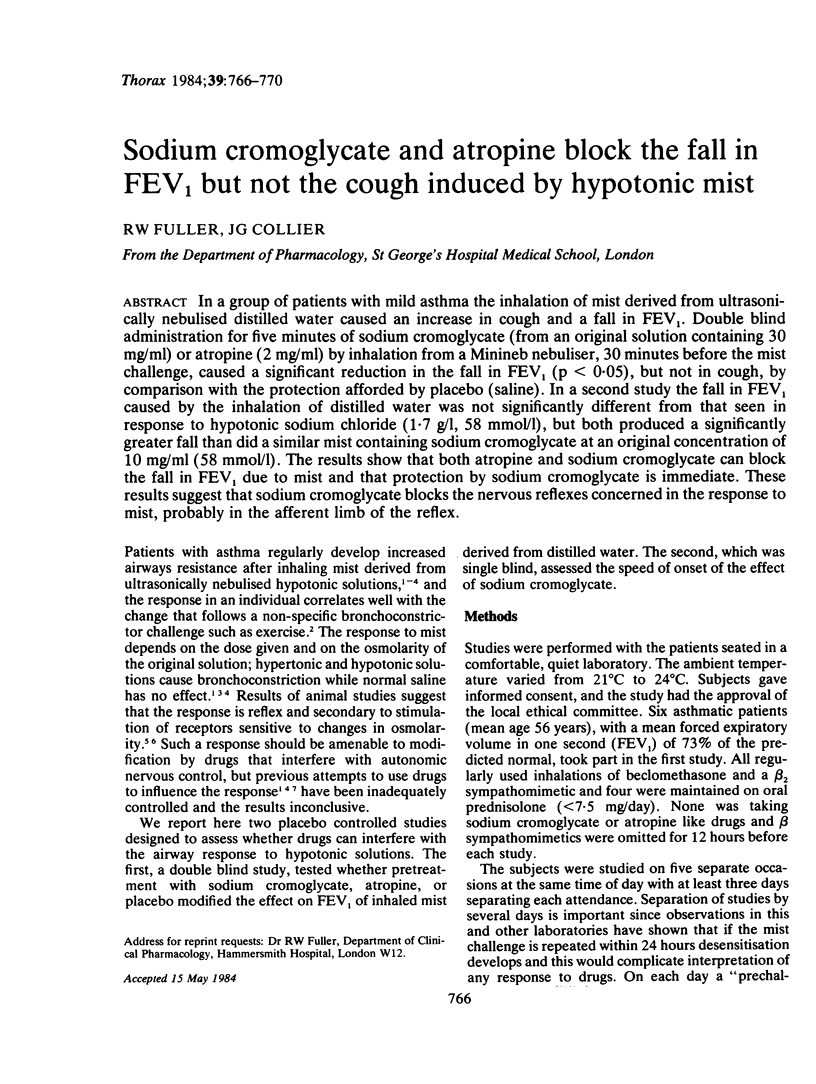
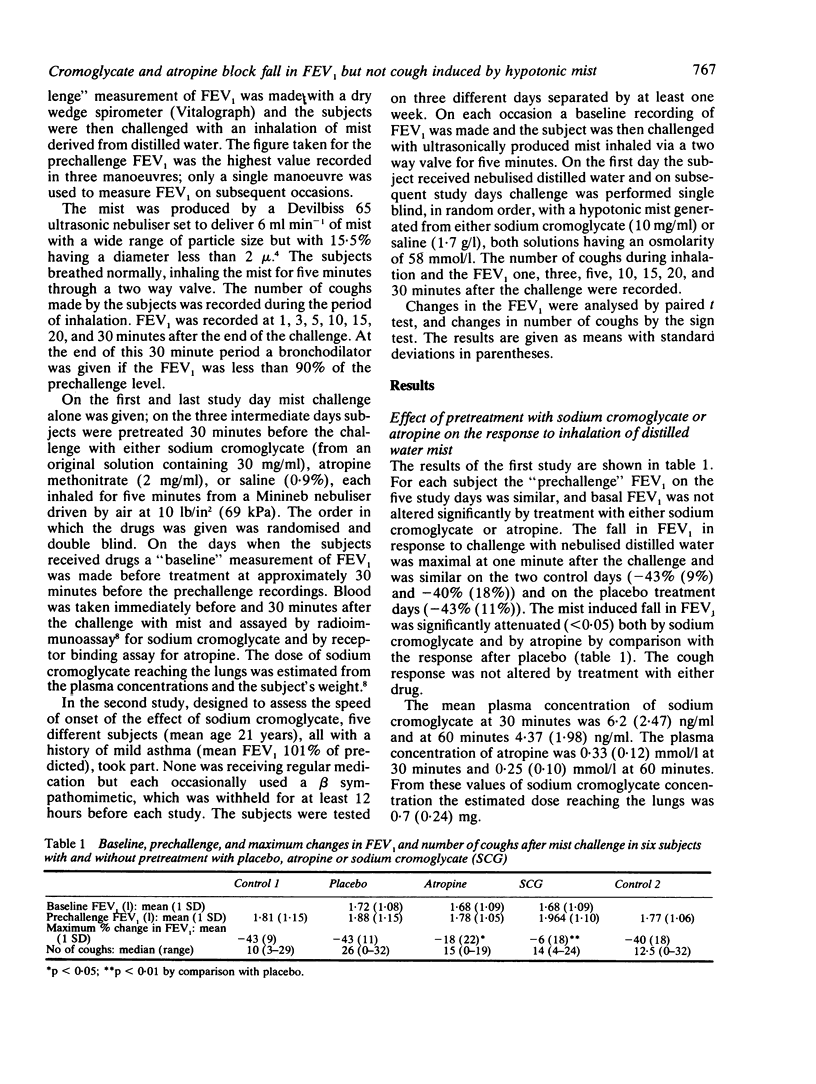
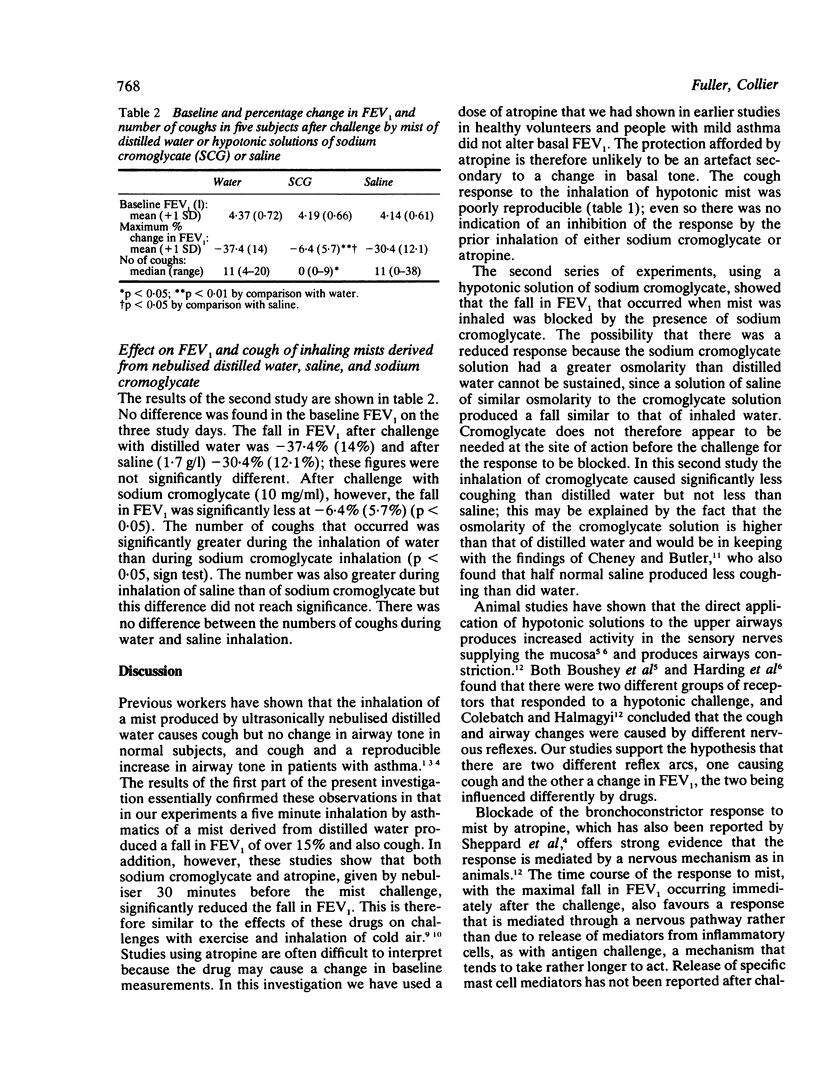
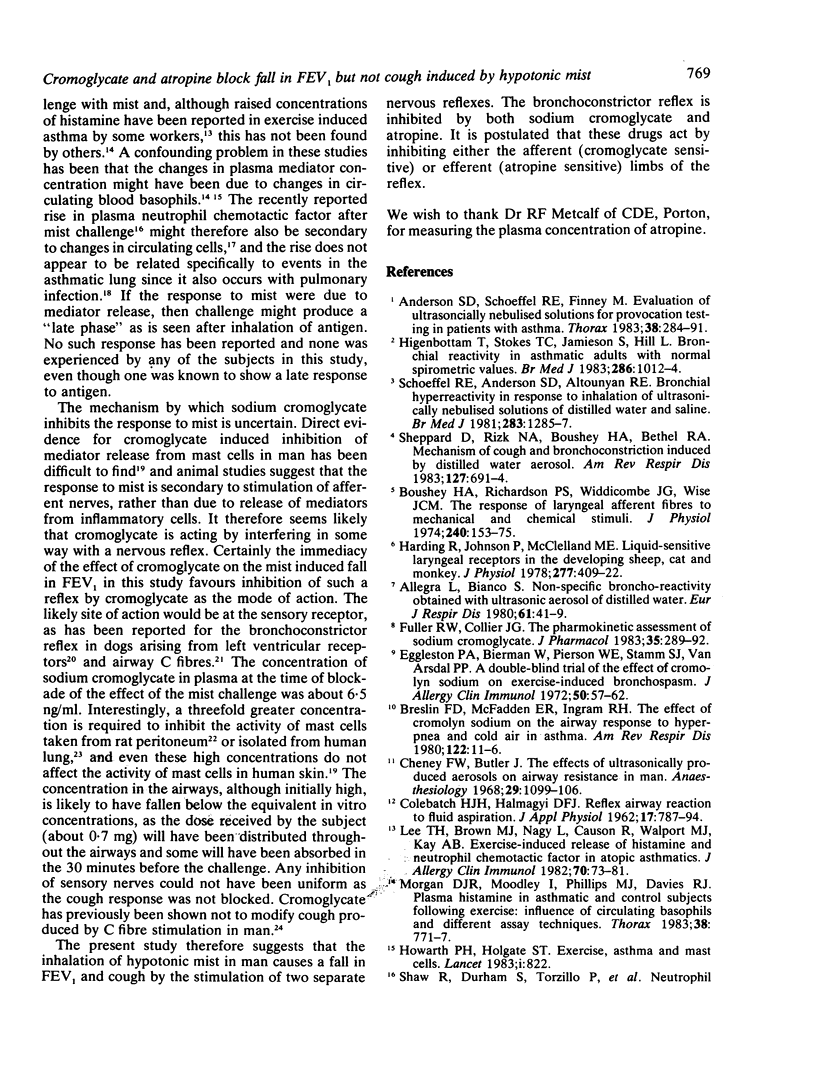
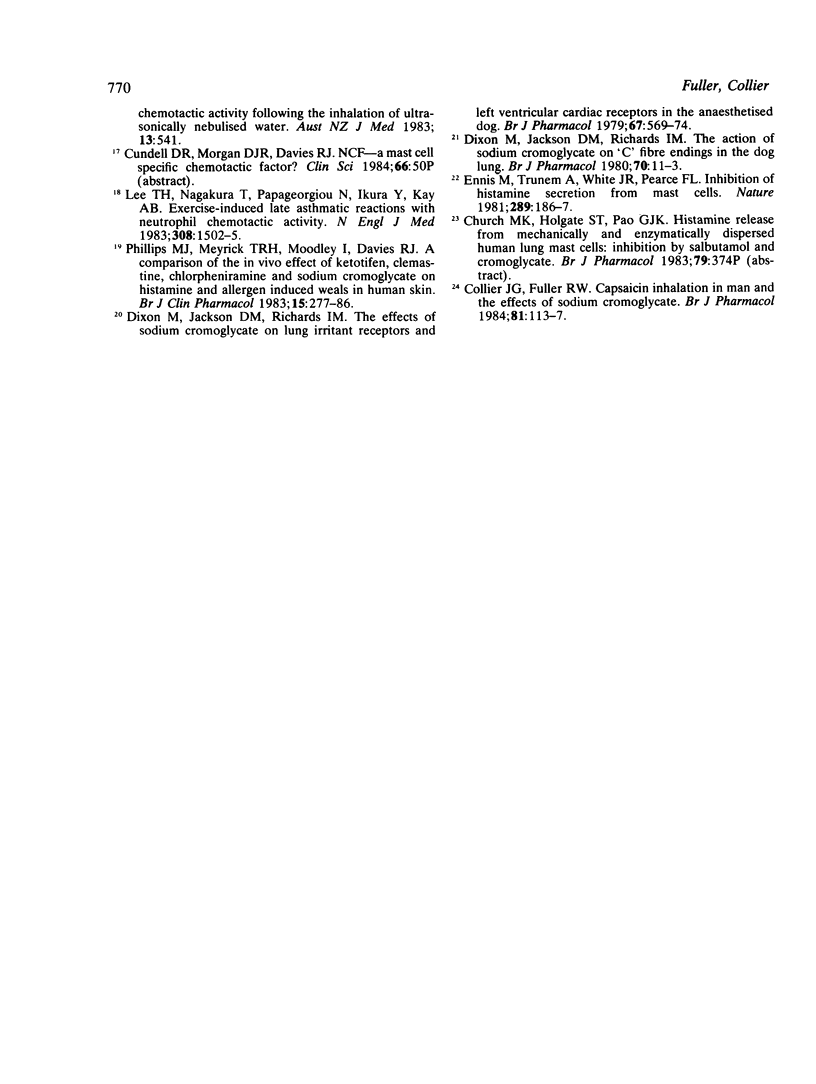
Selected References
These references are in PubMed. This may not be the complete list of references from this article.
- Allegra L., Bianco S. Non-specific broncho-reactivity obtained with an ultrasonic aerosol of distilled water. Eur J Respir Dis Suppl. 1980;106:41–49. [PubMed] [Google Scholar]
- Anderson S. D., Schoeffel R. E., Finney M. Evaluation of ultrasonically nebulised solutions for provocation testing in patients with asthma. Thorax. 1983 Apr;38(4):284–291. doi: 10.1136/thx.38.4.284. [DOI] [PMC free article] [PubMed] [Google Scholar]
- Boushey H. A., Richardson P. S., Widdicombe J. G., Wise J. C. The response of laryngeal afferent fibres to mechanical and chemical stimuli. J Physiol. 1974 Jul;240(1):153–175. doi: 10.1113/jphysiol.1974.sp010605. [DOI] [PMC free article] [PubMed] [Google Scholar]
- Breslin F. J., McFadden E. R., Jr, Ingram R. H., Jr The effects of cromolyn sodium on the airway response to hyperpnea and cold air in asthma. Am Rev Respir Dis. 1980 Jul;122(1):11–16. doi: 10.1164/arrd.1980.122.1.11. [DOI] [PubMed] [Google Scholar]
- Cheney F. W., Jr, Butler J. The effects of ultrasonically-produced aerosols on airway resistance in man. Anesthesiology. 1968 Nov-Dec;29(6):1099–1106. doi: 10.1097/00000542-196811000-00004. [DOI] [PubMed] [Google Scholar]
- Collier J. G., Fuller R. W. Capsaicin inhalation in man and the effects of sodium cromoglycate. Br J Pharmacol. 1984 Jan;81(1):113–117. doi: 10.1111/j.1476-5381.1984.tb10750.x. [DOI] [PMC free article] [PubMed] [Google Scholar]
- Dixon M., Jackson D. M., Richards I. M. The action of sodium cromoglycate on 'C' fibre endings in the dog lung. Br J Pharmacol. 1980 Sep;70(1):11–13. doi: 10.1111/j.1476-5381.1980.tb10898.x. [DOI] [PMC free article] [PubMed] [Google Scholar]
- Dixon M., Jackson D. M., Richards I. M. The effects of sodium cromoglycate on lung irritant receptors and left ventricular cardiac receptors in the anaesthetized dog. Br J Pharmacol. 1979 Dec;67(4):569–574. doi: 10.1111/j.1476-5381.1979.tb08703.x. [DOI] [PMC free article] [PubMed] [Google Scholar]
- Eggleston P. A., Bierman C. W., Pierson W. E., Stamm S. J., Van Arsdel P. P., Jr A double blind trial of the effect of cromolyn sodium on exercise-induced bronchospasm. J Allergy Clin Immunol. 1972 Jul;50(1):57–63. doi: 10.1016/0091-6749(72)90079-6. [DOI] [PubMed] [Google Scholar]
- Ennis M., Truneh A., White J. R., Pearce F. L. Inhibition of histamine secretion from mast cells. Nature. 1981 Jan 15;289(5794):186–187. doi: 10.1038/289186a0. [DOI] [PubMed] [Google Scholar]
- Fuller R. W., Collier J. G. The pharmacokinetic assessment of sodium cromoglycate. J Pharm Pharmacol. 1983 May;35(5):289–292. doi: 10.1111/j.2042-7158.1983.tb02936.x. [DOI] [PubMed] [Google Scholar]
- Harding R., Johnson P., McClelland M. E. Liquid-sensitive laryngeal receptors in the developing sheep, cat and monkey. J Physiol. 1978 Apr;277:409–422. doi: 10.1113/jphysiol.1978.sp012281. [DOI] [PMC free article] [PubMed] [Google Scholar]
- Higenbottam T., Stokes T. C., Jamieson S., Hill L. Bronchial reactivity in asthmatic adults with normal spirometric values. Br Med J (Clin Res Ed) 1983 Mar 26;286(6370):1012–1014. doi: 10.1136/bmj.286.6370.1012. [DOI] [PMC free article] [PubMed] [Google Scholar]
- Howarth P. H., Holgate S. T. Exercise, asthma, and mast cells. Lancet. 1983 Apr 9;1(8328):822–822. doi: 10.1016/s0140-6736(83)91880-9. [DOI] [PubMed] [Google Scholar]
- Lee T. H., Brown M. J., Nagy L., Causon R., Walport M. J., Kay A. B. Exercise-induced release of histamine and neutrophil chemotactic factor in atopic asthmatics. J Allergy Clin Immunol. 1982 Aug;70(2):73–81. doi: 10.1016/0091-6749(82)90232-9. [DOI] [PubMed] [Google Scholar]
- Lee T. H., Nagakura T., Papageorgiou N., Iikura Y., Kay A. B. Exercise-induced late asthmatic reactions with neutrophil chemotactic activity. N Engl J Med. 1983 Jun 23;308(25):1502–1505. doi: 10.1056/NEJM198306233082504. [DOI] [PubMed] [Google Scholar]
- Morgan D. J., Moodley I., Phillips M. J., Davies R. J. Plasma histamine in asthmatic and control subjects following exercise: influence of circulating basophils and different assay techniques. Thorax. 1983 Oct;38(10):771–777. doi: 10.1136/thx.38.10.771. [DOI] [PMC free article] [PubMed] [Google Scholar]
- Phillips M. J., Meyrick Thomas R. H., Moodley I., Davies R. J. A comparison of the in vivo effects of ketotifen, clemastine, chlorpheniramine and sodium cromoglycate on histamine and allergen induced weals in human skin. Br J Clin Pharmacol. 1983 Mar;15(3):277–286. doi: 10.1111/j.1365-2125.1983.tb01500.x. [DOI] [PMC free article] [PubMed] [Google Scholar]
- Schoeffel R. E., Anderson S. D., Altounyan R. E. Bronchial hyperreactivity in response to inhalation of ultrasonically nebulised solutions of distilled water and saline. Br Med J (Clin Res Ed) 1981 Nov 14;283(6302):1285–1287. doi: 10.1136/bmj.283.6302.1285. [DOI] [PMC free article] [PubMed] [Google Scholar]
- Sheppard D., Rizk N. W., Boushey H. A., Bethel R. A. Mechanism of cough and bronchoconstriction induced by distilled water aerosol. Am Rev Respir Dis. 1983 Jun;127(6):691–694. doi: 10.1164/arrd.1983.127.6.691. [DOI] [PubMed] [Google Scholar]


